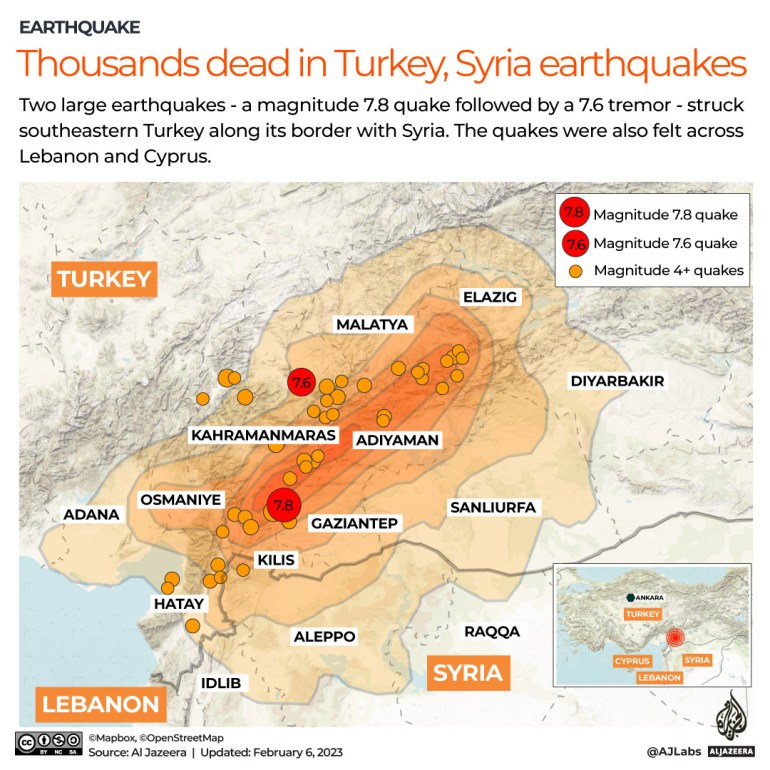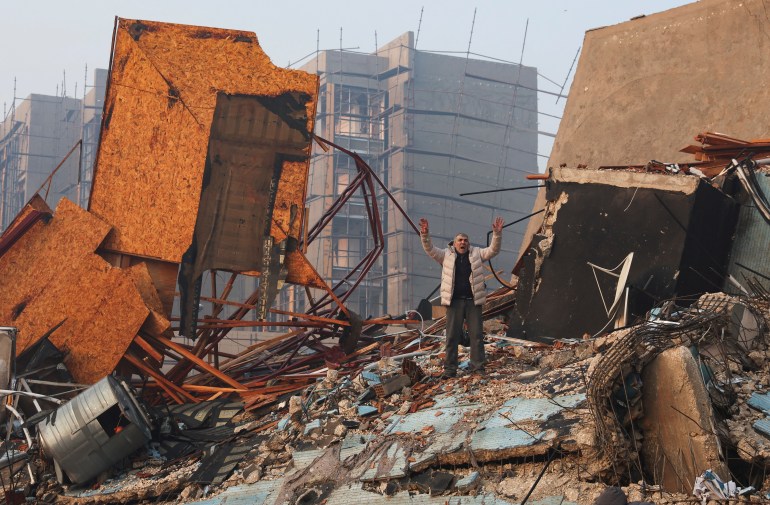Rescuers searched through the frigid night into Tuesday morning, hoping to dig out more survivors as those trapped cried out for help from beneath mountains of debris.
What do we know about the casualties?
Turkish authorities said the number of dead in Turkey had climbed to at least 3,381, while 15,834 others were injured, across 10 Turkish provinces.
In Syria, more than 1,400 people were killed. The death toll in government-held areas of Syria climbed to 656 people, with some 1,400 injured, according to the government’s health ministry. In the country’s rebel-held northwest, the White Helmets rescue organisation reported at least 700 fatalities and 2,000 wounded.
The number of dead in both countries is expected to rise.
Turkish President Recep Tayyip Erdogan has declared seven days of national mourning.

What do we know about the quakes?
The first magnitude 7.8 tremor stuck in the middle of the night with its epicentre in Kahramanmaras, in southeastern Turkey.
The quake was about 50km (31 miles) from the border of northwest Syria, where approximately 1.7 million internally displaced Syrians live in a cluster of camps in areas controlled by opposition groups still fighting the government of Syrian President Bashar al-Assad.
Several aftershocks followed, including a second quake with a magnitude of 7.6, causing damage in a vast area, including the cities of Antakya, Gaziantep, Sanliurfa and Diyarbakir in Turkey, and Idlib, Aleppo and Hama in Syria.
How are rescue operations going?
More than 7,800 people have been rescued across 10 provinces, according to Orhan Tatar, an official with Turkey’s disaster management authority. Strained medical facilities have quickly filled with injured people, rescue workers said.
The Syrian American Medical Society, which runs hospitals in northern Syria and southern Turkey, said in a statement that its facilities were “overwhelmed with patients filling the hallways” and called urgently for “trauma supplies and a comprehensive emergency response to save lives and treat the injured”.
Governments and aid agencies have rushed to deploy personnel. However, emergency crews on the ground have remained few and far between, with their efforts impeded by frigid temperatures and close to 200 aftershocks, making the search through unstable structures perilous.
More bad weather is expected to hit the region, further hampering rescue operations. Downed buildings and destroyed roads have also made it difficult to find survivors and get crucial aid into affected areas. Several airports have also been closed after being damaged by the earthquakes.
Harrowing accounts are emerging from isolated areas, such as in Turkey’s Hatay region, where officials say as many as 1,500 buildings were destroyed and many people reported relatives being trapped under the rubble with no aid or rescue teams arriving.

Who is stepping up to help?
Several countries have stepped forward to offer assistance.
The European Union has mobilised search and rescue teams, and the bloc’s Copernicus satellite system has been activated to provide emergency mapping services. At least 13 member countries have offered assistance. The United States has ruled out dealing directly with the Syrian government, but Washington is coordinating immediate assistance to NATO-member Turkey, including teams to support search and rescue efforts.
Pakistan has dispatched its first batch of rescue teams and relief goods to Turkey, while 10 units from the Russian military have already been deployed to Syria to help clear debris and search for survivors. Moscow has also offered help to Turkey, which has been accepted.
Jordan is sending emergency aid to both countries and Egypt has pledged urgent humanitarian help to Turkey. Lebanon’s cash-strapped government is also sending Red Cross and Civil Defence first responders and firefighters to Turkey to help with its rescue efforts.
